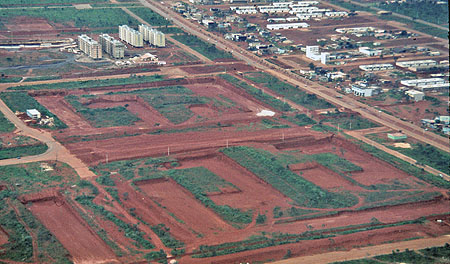HIS 112
Unit 13: Decolonization and Nation-Building

Photo of
Brasília, the capital of Brazil, under construction in the early 1960s. Brazilian President Juscelino Kubitschek authorized the building of the city as part of a
move of the capital from Rio de Janeiro to a new, more
central location in Brazil. Since the city was literally built entirely from
scratch, it was meant to symbolize a new start for the
country. See some additional photos. Photo courtesy C. Wayne and Dorothy Miller.
 What you
must do in this unit
What you can do in this unit
What you
must do in this unit
What you can do in this unit
- Listen to some further information about this unit
as a mp3 file.
You can also read the information as
a txt file
- Watch Hans Rosling's 200 Countries, 200 Years (the Joy of Stats) This quick video on Youtube takes a look at health/wealth data over the past two centuries to illustrate the development of the global world.
Some videos that you can watch for this unit
Extra Credit Options
- Take the short 5-point quizzes for chapters 36 and 37. Log into Blackboard and look under "Chapter Quizzes." You have five minutes to complete each quiz (multiple-choice questions).
- For extra credit of 50 points, in a one-page paper consider comparing the
Charter of the League of Nations with the UN Charter.
- In
a one-page paper, for a maximum of 50 points extra credit (maybe more), assess the
successes/failures of UN peacekeeping operations since 1945.
Please be sure to cite your sources. A good starting point is U.N. Peacekeeping
Operations.
- For a maximum of 50 points extra credit, read President John F. Kennedy On the Alliance for Progress (1961) and then Alberto Lleras Report on the Alliance for Progress (1963) and assess the rationale and the reality of the Alliance in a one-page paper.
- For a maximum of 50 points extra credit (maybe more), read President Sukarno of Indonesia: Speech at The Opening
of The Bandung Conference (April 18, 1955) and Prime Minister Nehru: Speech to Bandung Conference
Political Committee (1955) and Anwar el Sadat: Afro-Asian Solidarity and the World
Mission of the Peoples of Africa and Asia (1957) and write a one-page paper (maybe longer) in which you assess the rationale for the Non-Aligned Movement.
- For a maximum of 50 points extra credit, read Nelson Mandela, Speech on Release From Prison (*.pdf, 1990) and then his Inaugural
Address (May 10, 1994) and write a one-page paper in which you elaborate upon Mandela's vision for South Africa.
- For a maximum of 25 points extra credit, read A.L. Geyer The Case for Apartheid (1953) and write a paragraph summarizing the rationale of supporters of apartheid.
- For a maximum of 25 points extra credit, read Jomo Kenyatta The Kenya Africa Union is Not the Mau
Mau (1952) and write a paragraph explaining Kenyatta's vision for his country.
- For a maximum of 25 points extra credit, read excerpts from Kwame Nkrumah (1909-1972), I Speak of Freedom (1961),
and write a paragraph explaining Nkrumah's vision for Africa.
- For a maximum of 25 points extra credit, read U Thant The Congo Problem (1962) and write a paragraph explaining the problems faced by the Congo during the process of decolonization.
- For a maximum of 25 points extra credit, read the Charter of the Organization of African Unity (May 25,
1963) and write a long paragraph in which you explain the rationale and structure of the OAU.
- For 10 points maximum extra credit, answer the UN paragraph study sheet questions.
- For extra credit, please suggest a
relevant website for this unit of the course. Send the title of the site, the url and a
brief explanation why you find the information interesting and applicable to
the material being studied this unit.
|

